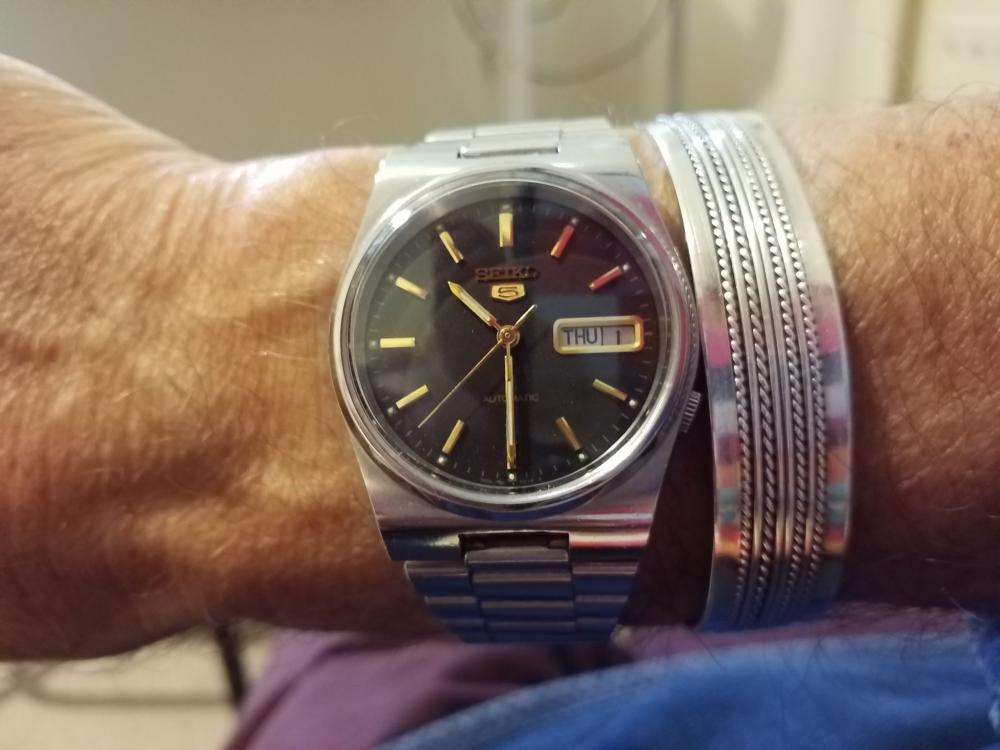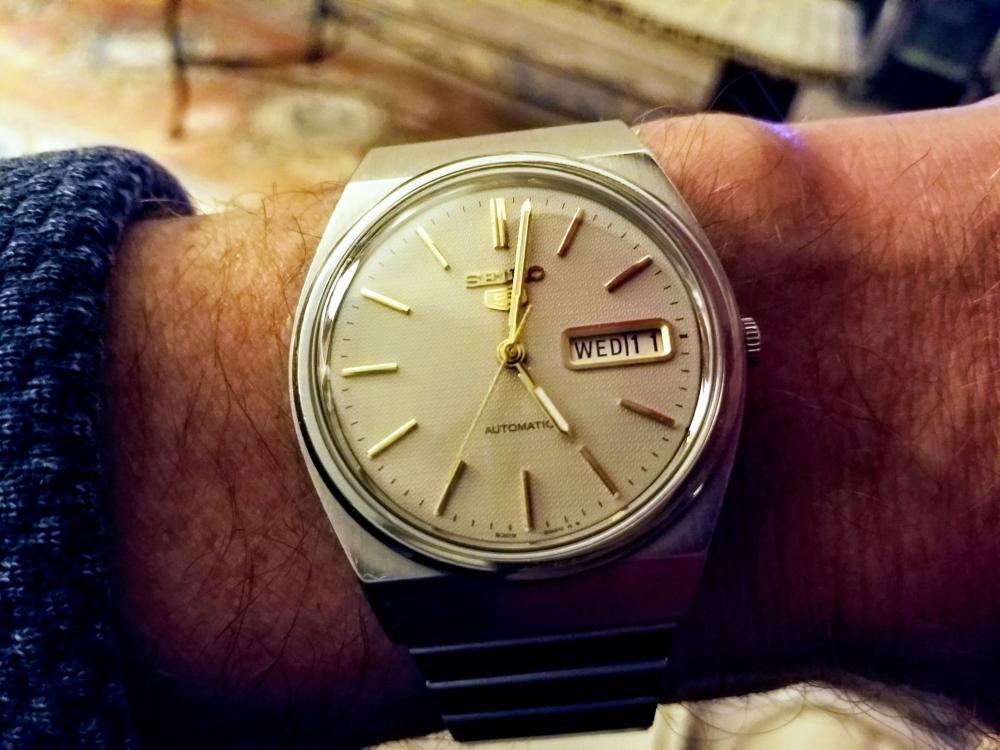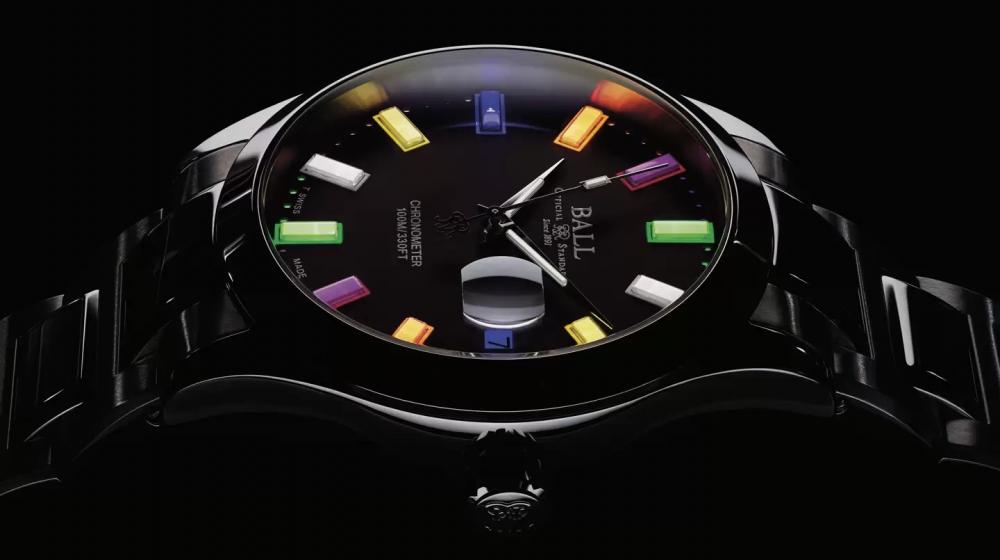Search the Community
Showing results for 'Radium'.
-
Should I be worried about radium?
JohnR725 replied to danizzz's topic in Chat About Watches & The Industry Here
I think the only real way to figure out at least radium is with the Geiger counter. The others have a long of a half-life that it's probably going be hard to detect those unless you have something really sensitive. That means basically they're not a problem. But radium is going to be a problem forever and I Geiger counter will definitely pick those up here's an amusing link the person talks about the letters all three are mentioned p.t & r but notice they're basically in reference to look how pretty The dials look. http://vintagewatchadvisors.azurewebsites.net/2019/07/20/seiko-pogue-authentication-part-ii-dials/ I think you'll find the next link interesting. There's a comment made about UV and how badly the phosphor has degraded Or basically UV is not a good test for radium. It's back to sensitive Geiger counter. https://www.hodinkee.com/articles/luminous-dials-what-makes-them-glow-and-how-to-spot-their-differences Problem with the question you have an marking dials is? They don't mark the dials with what they have unless there was some reason to. So initially radium was harmless so there's no need to put any markings on the dials. Then later on they did but I almost have a suspicion in the case of Seiko they might actually be referencing something else. So the R does not necessarily mean radium perhaps. The only way you can tell is with the Geiger counter.Then having Promethium And Tritium Shouldn't be a problem because her half life is short. What would be the interesting study is to study 100 watchmakers and see how many died from cancer of working on watches with radium dial's? I suspect the answer will probably be zero. Because it probably be impossible to figure this out and so many other things you could get exposed to that's bad for your health. -
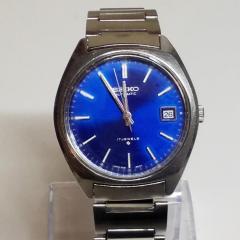
Should I be worried about radium?
Pluto replied to danizzz's topic in Chat About Watches & The Industry Here
Thanks for the info JohnR725. Interesting reading. The dial codes for these two watches are Black one 7009 468R R and dated 1993, the silver/grey one 6309 892M R dated 1984. Incidentally, my friends brand new 7S26 has a dial code 04M4 R2. So I'm not sure what the significance of R is but surely not radium as per the Swiss watches? I don't seem to becable to get a definitive answer on these watches as it may be lost in time? -
Should I be worried about radium?
JohnR725 replied to danizzz's topic in Chat About Watches & The Industry Here
The simple answer would be the only way you know if your radium free is to have a Geiger counter. But because these are Seiko's late enough there probably not radium. Typically radium is in the older watches or watchmakers who accumulate new old stock happens with zero idea when those hands were made. Out of curiosity did a Internet search. The link below comments about Seiko. We need a better picture of the dial out the bottom. Usually on newer watches they'll put a symbol like T Obviously for tritium. So I've seen that on the other watches looks like from the discussion that Seiko used R or RAD What about the nonradioactive stuff that glows wouldn't that light up with your UV light? So just because you the UV light causes If the light up does not mean it's evil and bad. At work we used to have a UV flashlight complements of one of the watch companies so we could show the customer how bright the dial Lights up at night. So UV is not a good test other than telling you that there's probably nothing that glows on the dial. Searching for that word it looks like the P is on the dial then that's what's there. Or basically it looks like Seiko for anything new or marks if there is something unique about whatever's on the dial. It's only would be the older stuff with everybody else and Seiko where they didn't market. Then the second link it talks about the nonradioactive material which I'm sure lights up with your UV flashlight which is why it's not much of a test for anything other than it gives you a clue something is glowing on the dial. https://www.thewatchsite.com/threads/do-vintage-seikos-use-rhodium-and-tritium-in-their-dials-and-hands.263289/ https://www.keepthetime.com/blog/seiko-lumibrite/ Recent discussion indicates that it's recent and that's where this discussion really should be? The size is an ongoing discussion. -

Should I be worried about radium?
Pluto replied to danizzz's topic in Chat About Watches & The Industry Here
With this recent discussion on radium, I'm a bit confused and would appreciate some advice on the Seiko watches I have please. These are from 1972 to mid 1990's and are mostly 6602, 6309, 7005 and 7009 movements. These watches no longer glow in the dark but if I shine my ultra violet light on them it lights up all the lume on the dial and hands. I would therefore appreciate any advice on the following points. 1. Is this lume radium, tritium or promethium bearing in mind the make and age of my watches? 2. I have read Seiko did not use radium, does anyone know this for certain? 3. I have also read that Seiko used promethium rather than tritium? 4. Is the lume on these watches still likely to be radio active and how safe is it to work on them? 5. If my UV light does not show up any lights on the dial/hands does it indicate it is lume free and safe? Any advice would be most welcome. -
The high end vintage watch market is dominated by "untouched" stuff these days. A Rolex from 1980 with a perfect dial is looked at with suspicion, if there are cracks and sun damage the price goes up 5k. In the thousand buck and under range folks still prefer "original with wear" to restored. This is talking case/dial/hands. For antique stuff, talking movement, it's case by case. A 17 jewel Longines pocketwatch, I won't hesitate to bore out a plate or bridge to replace a cracked burished in jewel with a friction jewel (it can be done so it's invisible unless disassembled). If it's a really nice, rare piece, then it's a question of what the client wants. And price. In school we were taught there are 3 levels, repair, restoration, and conservation. A repair might bring back original function, but like above, would be evident on inspection. Restoration you try to bring it as close to original condition as possible. Conservation, you might clean things and remove rust and such without altering it in any way, even if the end result isn't functional- the goal is to keep as much originality as possible. I remember 20 years ago it was normal to buff cases and send dials out as a matter of course. Now if a case gets retouched there are folks who will laser weld dings and refinish to absolute factory original condition, with lapping machines that can reproduce the original crisp lines or the crazy "brushed" finish that was never done with a brush in the first place. Dials likewise are often left with their age showing, hands with manky oxidation around the radium might get a little coat of lacquer on the underside to stabilize them.
-
Hi folks, I just wanted to say hello after finding this forum today. I am a total newb to watch restoration, and have recently acquired several Ingersoll midget wrist watches with wire lugs from an estate. They are all intact and as I am told were collected in the mid 20's and put into storage after the local regiment sprang for new watches for all the officers. There are six in total. All with original canvas straps and one with a leather strap. I am hoping to get them all serviced and running and yes I know they were throw away watches in the day, but many have said they can be serviced and I have the means to dispose of the radium, so that is a good thing. Any and all help is much appreciated. Cheers, Trench
-

Should I be worried about radium?
LittleWatchShop replied to danizzz's topic in Chat About Watches & The Industry Here
My dad's watchmaking career was from 1947 until 1990. He handled many many watches with radium. He died at age 93...cancer free (as far as we knew). It is a single data point, however. He was also a big fan of Chlordane...used it on everything except his breakfast cereal. Go figure. -
Should I be worried about radium?
thewatchdoctor replied to danizzz's topic in Chat About Watches & The Industry Here
I would worry about it to much however read up about the radium girls who used it as florescent lipstick -
As I've heard it, "waterproof" was what they called water-resistant watches before the 1960s when consumer protection laws were put into place limiting use of the misleading phrase in the US. Almost certainly radium lume, radioactive, half-life of 1600+ years, don't breathe the dust, read up on material safety when working with it. Some people love the tired old brown lume look, and will replace lume to preserve the look or pay big $$$ for original examples. Others call it dog-s**t lume, and will re-lume the watch to make it look green/white like the lume did when new (except with safe modern lume compound). I've got a few 1950s watches where the lume dots (circles and triangles) have outlines painted on the dial. Absolutely would need to replace the gasket, crown and probably crystal to regain water resistance.
-
My wild guess is that it's lume. It's interesting dial in that they printed the outline of the numbers. This would allow somebody to hand paint the luminescent material on and know where to do it. It'd be interesting to knowing the time frame that the dial and/or watch was made. I'm guessing because it says the word waterproof we can narrow it down for that. Finding a modern luminescent material that's darkening colors going to be interesting. Then because this is a holder luminescent material it's probably dark because it's radium based. But you need a Geiger counter to verify that.
-

Should I be worried about radium?
Graziano replied to danizzz's topic in Chat About Watches & The Industry Here
Also a lot of other antique items contain radium or its equivalent Clocks, watches and dials that glow-in-the-dark without the use of a battery may contain radium or tritium. Ceramics made until the 1970s may have glazes colored with radionuclides. Vaseline glass, or canary glass, contains a small amount of uranium. This gives the glass its yellow-green color. It also makes the glass glow bright green under a black light. Cloisonné jewelry gets some of its yellow, orange and off-white colors from small amounts of uranium in the glaze. Radioactive antiques can continue to emit very low-levels of radiation for thousands of years, if not longer. The amount of radiation these items emit is small. However, it can register on a hand-held Geiger counter if the object is close enough to the monitor. -
Should I be worried about radium?
Fred48 replied to danizzz's topic in Chat About Watches & The Industry Here
As a retired medical radiation physicist, I would be very wary of radium as it's half life is 1600 years (as opposed to tritium which is 12 years), which means it's strength won't diminish in our lifetimes for sure. So, I personally would not wear a radium dial watch 24/7 as it is close to the skin, constantly exposing with alpha, beta, and high energy gamma rays (so sticking radium hands in a typical lead box doesn't really do much), and the radiation level varies from watch to watch. Granted, it's probably small, but is cumulative over time and increases significantly the closer it gets to you. And, as has been previously pointed out, inhalation or ingestion of radium particles is especially bad as now the radium is up close to internal organs like the lungs. Also, proper disposal of radium is tricky as it's effect never diminishes. Companies that dispose of radioactive material as a business have state licenses that they must adhere to; watchmakers? I doubt it. https://www.livescience.com/39623-facts-about-radium.html#:~:text=Radium emits alpha particles (two,according to New World Encyclopedia. -
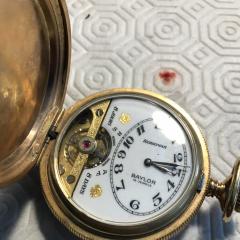
Any thoughts on this Watch and Strange Rotor
jdrichard replied to jdrichard's topic in Watch Repairs Help & Advice
Thanks. I do have another 24 Jewel incabloc. Btw, this watch has a radioactive radium dial. -
Wondering what everyone’s method/material is for color matching very old lume on watch hands. I don’t want it to glow, just refill the hour hand to match the old minute hand, as the radium “paint” is gone from the hour hand.
-

Should I be worried about radium?
AndyHull replied to danizzz's topic in Chat About Watches & The Industry Here
I think what this all boils down to is... Always wear gloves if you are removing anything toxic or radioactive. No need for lead lined ones, just something that will stop you absorbing stuff through your skin. A couple of pairs of standard latex "covid proof" ones will probably be fine. Even if you have worn gloves, (and particularly if you haven't) wash your hands carefully afterwards. The same rules for radium apply for other relatively common hazards such as lead, mercury, cadmium, low levels of asbestos and arguably even chrome. They and their compounds are all cumulative toxins, so the more you handle them, the more damage they could potentially be doing. Having said that, I've been frequently using lead solder for years, and other than washing my hands afterwards, I don't worry too much about it. I suspect the majority of the lead in my tissues is probably from the days of leaded petrol rather than soldering. Also, as stated previously, be aware that airborne dust is probably the major issue with radium (and heavy metals, asbestos etc.). Wear a dust mask, and keep everything "wet" with some suitable wetting agent if you can. Dispose of the waste carefully. -
Should I be worried about radium?
LeeReynolds replied to danizzz's topic in Chat About Watches & The Industry Here
Besides being continuously irradiated unnecessarily, my primary worry was accidental ingestion of the radium itself. Here's the process I used on the hands, as presented by the world famous Nekkid Watchmaker: -
Should I be worried about radium?
LeeReynolds replied to danizzz's topic in Chat About Watches & The Industry Here
I've got two other watches that are like that, a "Louis" and a "Den-Ro" I was able to remove the radium from the hands, but not the dials. One now gives readings of ~ 1.5 microsieverts per hour. The other now gives ~ 0.9 per hour. I don't remember how "hot" these were before I removed the radium from the hands. -
Should I be worried about radium?
LeeReynolds replied to danizzz's topic in Chat About Watches & The Industry Here
12.79 microsieverts per hour is more than what I was seeing on my watch. I was only getting around 10. I hate the fact that so many older watches with lume are radium based, and the people selling them on Ebay have no idea. I was able to remove virtually all of the radium from the hands on mine, very carefully, by keeping the hands submerged in alcohol and using peg wood to scrape off the lume. Then I ran the hands through several ultrasonic cleaner cycles. My watch now reads 0.30 microsieverts an hour, which is roughly double the background radiation in my house Does your watch have radium in the dial, or just the hands? If it is just in the hands then you may be able to do the same. -
I do so with the question " Should I worry about radium? " and the guy always buys a gieger counter on ebay, handy for checking neighbours blood pressure with. Another one, " which watch are you wearing today" how about yesterday? and always a timex shown which someone else has already throw up on.
-

Should I be worried about radium?
AndyHull replied to danizzz's topic in Chat About Watches & The Industry Here
True, from the dial side, but what was the dose through the case? What was the dose through the crystal? Mostly Radium throws out Alpha and Beta radiation, so most of that isn't going anywhere. https://en.wikipedia.org/wiki/Isotopes_of_radium#Radium-226 Some of the gamma will get out. Dust is the real hazard. Take care when dealing with that. -

Should I be worried about radium?
AndyHull replied to danizzz's topic in Chat About Watches & The Industry Here
1 million years = 31556952000000 seconds (3.155 x 10^13 seconds) https://en.wikipedia.org/wiki/List_of_radioactive_nuclides_by_half-life Radium 226 has a half life of 50x10^9 seconds or around 1,600 years .. so 1 million years will probably make the lume on those hands safe enough to spread on your toast. Having said that, the radioactivity is relatively low level, so providing you don't actually intend spreading the lume on your toast, and it will remain in the watch, and that the watch is not worn daily, for may years, then its probably not worth worrying about. Most of the activity is absorbed by the dial and case. A small amount of gamma might make it through the case to you, and a little more might make it through the crystal, but not enough to loose any sleep over. An international flight, or a tooth x-ray, or even a days worth of bright sunshine will do more damage. A banana a day would probably be similarly dangerous ( as wearing the watch, not eating it obviously, the watch would be a choke hazard). -
Should I be worried about radium?
LeeReynolds replied to danizzz's topic in Chat About Watches & The Industry Here
I've read things online about the radium dials and hands being dangerous. I've also read things that say not to worry. My take is that anything which gives you 24 hours of radiation in a few minutes is probably a bad thing to have on your arm. Something that will shed radioactive dust when taken apart is something I want even less to do with. There's a huge difference between having something radioactive near you -- or on you -- which will give your entire body a dosage of radiation, and having a small speck of radioactive material lodged in your lungs irradiating the immediate area continuously for an indefinite period of time. I wish I'd waited till I got this geiger counter to take that watch apart. I won't make that mistake again. Let's not forget that radium decays into radon. Where I'm from, most people have radon detectors, especially if they have a basement as the stuff comes up out of the ground. I don't need it coming off my arm. This is the geiger counter I bought: If anyone is interested, I can post a video of the readings I'm getting from it. -
Found this interesting article about luminous watches: Using photoluminescent material to show the time in low-light conditions is a practice that has been employed since the development of the earliest wristwatches. Originally, radium was used on hands and indexes, which had the benefit of a bright and long-lasting glow, counterbalanced by the disadvantage of being highly radioactive and a major health issue for those who applied it. In the 1960s, radium was replaced by the much safer, yet still radioactive, tritium, which was phased out in the 1990s when alternatives like strontium aluminate (in the form of Super-LumiNova) came to market. The idea behind practically all forms of ‘lume’, though, is that they absorb light during the day, store it and then emit it in the dark. The most common colours are blue, green and white, but this is by no means all that is available. Usually coating hands and indexes, the more adventurous manufacturers - like the ones listed below - have found ways to add light shows to dials, bezels, cases and even straps. A good example is the following beauty.See pic Price: £1,800 | Ball Watch Co. According to Ball watch, the self-powered micro tubes that have become its trademark are 100 times brighter than standard luminous coatings, and, although the glow will gradually fade over time, a replacement dial will easily solve the problem. The illumination is achieved through H3 tritium gas, safety-sealed in mineral glass tubes that are coated with a luminescent material. And nowhere is the light brighter than in the recent Engineer III Marvelight. With rainbows now a symbol associated with 2020 and the global fight against Covid-19, Ball has issued the limited-edition 40mm watch with multi-coloured gas tubes. For every piece sold, 300 Swiss Francs will be donated to The Salvation Army.
-
Thanks for the replies they are much appreciated - I did wonder about the main spring but as the dial is not in great condition I don't intend to turn this into a working watch it is not that important. I have though made some progress in the last 3 or 4 hours, the position and orientation of the main central gear is obvious, I think it is for the minute hand - one of the gears in the train has an extended shaft so this goes in the position for the seconds sub dial so the third gear must go in between - the last position can only be for the escapement wheel, it took a while to work out which way up the escapement wheel and middle gear went and after a 30-40min struggle the top bridge finally dropped on and the gears all meshed, after spending some time working out which way to install the spring and spring winding arbor into the barrel, I found that I couldn't juggle the main spring barrel into place and should have installed the main spring barrel first. I guessing there are plenty of forum members that have been there and done that. I'm at the stage where the gear train is assembled, main spring and the two gears that go with it are on and the pawl that holds the main spring in tension is in place, but I can't find a spring for the pawl, there is a very small bit of bent wire only a few mm long - it may be the spring I'll have to study it for a while and see if it will fit. I'll give it a rest for now it's getting late and I don't want to push my luck. There are no identifying marks on the movement - just 15 jewels swiss made, the dial is marked GALA - I suspect it is a radium dial, it does not glow after being in bright sunlight for 10 or so mins. I did spend a whole evening the other day on bidfun-db looking at movements but there is just so many I gave up.

